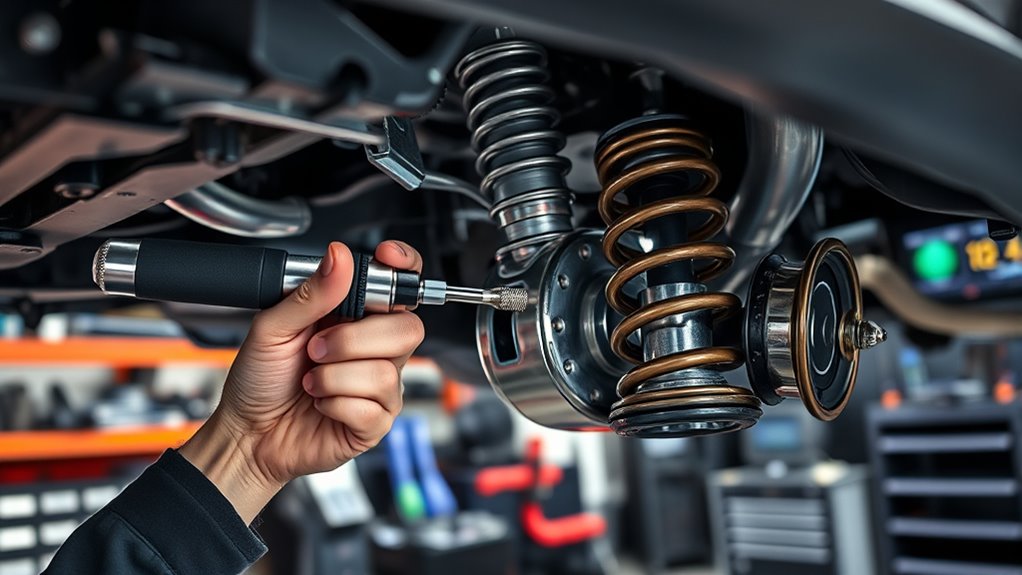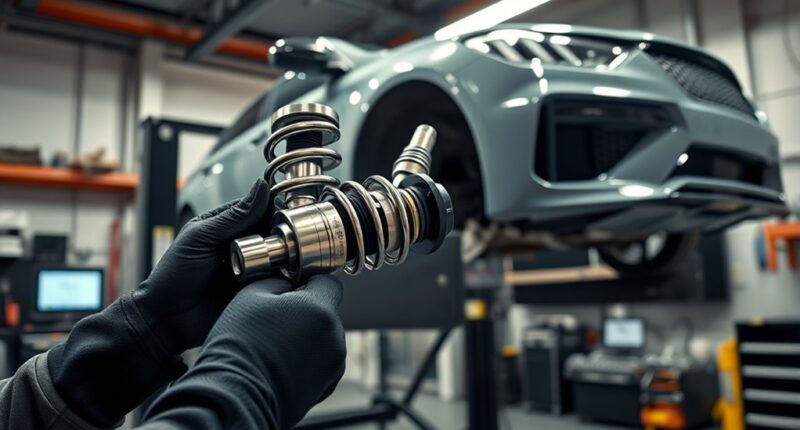When installing aftermarket suspension, start by carefully adjusting the ride height to match manufacturer specifications or your preferences, ensuring all wheels are level. Afterward, use specialized scan tools or software to recalibrate your sensors—this step is vital to prevent false alerts. Always follow the manufacturer’s instructions for both suspension and sensor calibration. If you keep these steps in mind, you’ll maintain safety and avoid warning lights. For detailed tips, there’s more to learn on this topic.
Key Takeaways
- Measure and document the vehicle’s original ride height before installation for accurate comparison afterward.
- After installing aftermarket suspension, adjust the ride height to manufacturer specifications or personal preferences.
- Use appropriate diagnostic tools or scan software to recalibrate sensors affected by suspension changes.
- Follow the vehicle manufacturer’s calibration procedures, including driving calibration distances if required.
- Verify all sensors and safety systems are functioning correctly post-installation and calibration to prevent false alerts.

Upgrading your vehicle’s suspension can substantially improve handling and ride quality, but installing aftermarket suspension components requires careful planning and preparation. One critical aspect you need to focus on is sensor calibration. Modern vehicles rely heavily on sensors for stability control, anti-lock brakes, and suspension height monitoring. When you change suspension components, these sensors can become misaligned or provide incorrect readings, which might trigger warning lights or even disable certain safety features. To avoid this, you must guarantee proper sensor calibration after installation. This involves resetting or recalibrating the sensors so they accurately reflect your new suspension setup. Many vehicles require specialized scan tools or software to perform these calibrations correctly. Skipping this step can lead to false alerts and compromised vehicle safety, so it’s worth investing the time and effort to get it right.
Another vital step is adjusting the ride height. After installing aftermarket suspension components, your vehicle’s ride height is likely to change, which can affect handling, tire wear, and the overall driving experience. Adjusting the ride height involves setting the suspension to the desired level, typically aligning with manufacturer specifications or your personal preferences. Proper ride height adjustment ensures your vehicle handles predictably and maintains correct clearance from the ground. It also helps prevent uneven tire wear and suspension strain. Depending on the type of suspension components you’ve installed, ride height adjustment can be achieved through adjustable coilovers, air suspension systems, or other means. Make sure to measure the height from a fixed point on the vehicle to the ground on each side to guarantee balance. A level ride height across all wheels is essential for maximum performance.
When adjusting the ride height, keep in mind that it might affect sensor calibration. Some sensors are sensitive to changes in height and position, so after making height adjustments, you may need to recalibrate the sensors again to confirm everything functions smoothly. This process might involve driving the vehicle for a specific distance or using diagnostic tools to verify proper sensor operation. Always follow the manufacturer’s guidelines on sensor calibration and ride height adjustment to prevent triggering alerts or compromising safety systems. Additionally, incorporating well-being tips such as ensuring proper maintenance and calibration can contribute to a safer and more comfortable driving experience.
Frequently Asked Questions
Will Aftermarket Suspension Affect My Vehicle’s Warranty?
You might wonder if aftermarket suspension affects your warranty coverage. Generally, it can, especially if it’s not installed properly or causes damage. Check your manufacturer restrictions, as some brands limit warranty coverage if modifications void specific parts. To avoid issues, keep receipts and document the installation process. Staying within these guidelines helps protect your warranty coverage while customizing your vehicle’s suspension.
How Do I Ensure Compatibility With My Specific Vehicle Model?
To guarantee compatibility with your specific vehicle model, you should perform a thorough compatibility check by referencing your vehicle’s manual and consulting manufacturer guidelines. Additionally, sensor calibration is essential; after installation, recalibrate sensors to prevent triggering alerts. Double-check that the aftermarket suspension components match your vehicle’s specifications, and consider seeking professional advice or installation to guarantee proper fit and maximum performance without affecting your vehicle’s systems.
Can I Install Aftermarket Suspension Myself or Need Professional Help?
You can attempt DIY installation of aftermarket suspension if you have the necessary tools and mechanical skills, but professional assistance is advised for safety and proper setup. While DIY saves money and gives you hands-on experience, a professional ensures correct installation, especially for complex systems. Consider your experience level and the complexity of your suspension to decide whether to tackle it yourself or seek expert help.
What Tools Are Required for Installation Without Triggering Alerts?
Picture yourself as a skilled surgeon, wielding precise tools to guarantee a smooth operation. To install aftermarket suspension without triggering alerts, you’ll need basic hand tools like wrenches, a jack, and a torque wrench. Focus on sensor calibration during installation to prevent alert triggers. Properly securing components and carefully managing wiring are key for alert mitigation, helping your vehicle adapt seamlessly without raising suspicion or triggering system warnings.
How Does Aftermarket Suspension Impact Vehicle Sensor Systems?
Aftermarket suspension can affect your vehicle’s sensor systems by altering height and alignment, which may disrupt sensor calibration and trigger warning systems. When you change suspension components, you need to recalibrate sensors like the ABS and adaptive cruise control to guarantee they function properly. Failing to do so might cause false warnings or system malfunctions. Proper calibration maintains sensor accuracy and prevents warning alerts, keeping your vehicle safe and compliant.
Conclusion
So, you’ve successfully installed and configured your aftermarket suspension without setting off any alarms—what a feat! Ironically, the real challenge was probably resisting the urge to show off your upgraded ride. Now, you can enjoy smoother rides and stealthy performance, all while keeping a low profile. Just remember, sometimes the best upgrades are the ones that go unnoticed—unless you’re enthusiastic for that next unexpected alert to keep things interesting. Happy driving!










